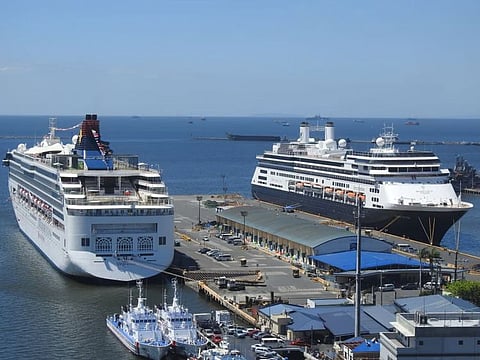Look: Fair winds boost cruise tourism in the Philippines
How the country won ‘Asia’s Best Cruise Destination’ award

Manila: There was a time, not so long ago, when port calls by luxury cruise ships were unheard of here. The reasons: instability, insurgency, infrastructure (lack of it).
The times, Bob Dylan once wrote, they are a-changing.
On Monday, February 26, 2024, Pier 15 at Manila South Harbour welcomed the simultaneous docking of two international cruise ships. It marked a significant influx of about 4,000 foreign tourists exploring local destinations.
The back-to-back port calls highlight how the Asian country has been emerging as a notable destination for cruise tourism.
A number of trends are shaping this sector. The country's cruise tourism is on a roll – the country had 128 cruise calls in 33 destinations in 2023.
This 2024, at least 132 cruise ships are expected to call ports of the Philippine islands bringing in about 100,000 passengers on board, according to the Philippine Ports Authority (PPA).
The dual cruise port call in Manila marked the second return of MV Westerdam (owned by Holland America) to the Philippines this year – while MV Norwegian Jewel (owned by Norwegian Cruise Line) also made a successful comeback, according to the Philippine Ports Authority (PPA).
The world-famous Boracay Island, in central Philippines, has already been visited by three international cruise ships in the first two months of 2024.
It is reaping the government’s whole-of-nation strategy to boost visitor arrivals, generate jobs, capitalise on its linkages with neighbours and showcase the country’s unique offerings.
MV Westerdam (1,970 passengers) arrived in Manila from Taiwan, while MV Norwegian Jewel (2,376 passengers) made a prior stop at the Port of Princesa, in Palawan, on the country’s west on February 24.
Tourism support, traffic plan
The upward trajectory of cruise tourism is driven by increasing demand, infrastructure development, and collaborations promoting the country as a premier destination.
In anticipation of the organised and seamless arrival of the two cruise ships, the PPA primed their staff and worked with the Port Police to ensure the safety and security of passengers at the pier.
Meanwhile, 50 tourist buses were stationed at the pier to facilitate tourist exploration of Manila and Tagaytay.
A traffic flow plan was devised, with separate lanes for bus tour passengers and those opting for a Do-It-Yourself Tour.
5 cruise terminals to be developed
To boost cruise tourism infrastructure this year, and in order to keep the country's best destination in Asia title, the PPA said it is developing at least five cruise terminals – in Boracay, Coron, Camiguin, Siargao and Puerto Galera – all of which are considered tourist hotbeds.
There has been a growing interest in cruise tourism in the Philippines, both among international travelers and domestic tourists.
The country’s natural coastal landscapes, pristine beaches, and rich cultural heritage make it an attractive destination for cruise travelers.
7,600 islands
The Philippines, an archipelago of more than 7,600 islands, offers an alternative to international cruise lines diversifying their routes – to include more destinations within the islands.
Traditionally popular ports of call such as Manila, Boracay, and Palawan continue to be frequented – but there's also an exploration of lesser-known ports like, Laoag, Matnog, Siargao, Davao, and Cebu.
'Asia's Best Cruise Destination' award
Last year, the Philippines was honored as "Asia’s Best Cruise Destination" at the esteemed World Cruise Awards for the first time, solidifying its status as a rising star in global cruise and tourism.
The World Cruise Awards, affiliated with the renowned World Travel Awards, annually recognises excellence in the cruise industry, drawing anticipation from cruise professionals, media, and consumers worldwide.
Competing for the award were India, Japan, Singapore, South Korea, Sri Lanka, Taiwan, Thailand, and Vietnam.
As of October 16, 2023, the Philippines was projected to have 128 cruise calls in 33 destinations, welcoming an estimated 101,000 passengers and 50,000 crew members.
Christina Garcia Frasco, Secretary of the Philippine Department of Tourism (DOT), cited the country's natural beauty, beaches, marine life, and hospitality, offering diverse cruise experiences.
Notable cruise ships that visited include the Seaborne Encore, Silver Shadow, MSC Poesia, Queen Elizabeth, Norwegian Jewel, Coral Adventure, MS Seven Seas Explorer, MS Star Breeze, Silver Whisper, Oceania Cruises, Aidabella, and the Blue Dream Cruise on its maiden voyage to the Philippines.
With Boracay, Palawan, and Siargao recently receiving Conde Nast Travel’s Best Islands in Asia Award, the recognition as Asia’s Best Cruise Destination further cements the Philippines as a must-visit for cruise enthusiasts.
Economic impact
This award validates the tourism industry's push, highlighting lesser-known destinations in the future. Secretary Frasco expressed gratitude for the recognition, highlighting the global preference for the country's island destinations.
She credited shared efforts by the government and the private sector for this success, pledging to maintain and enhance the Philippines’ reputation as an outstanding cruise destination.
Partnerships for sustainability
The government, tourism authorities, and local communities are actively collaborating with cruise lines and international organisations to promote the Philippines as a cruise destination.
Health and safety protocols have become a top priority for the cruise industry. Cruise lines operating in the Philippines are implementing rigorous health measures to protect passengers and crew members, including vaccination requirements, testing protocols, and enhanced sanitation practices.
There's a growing emphasis on environmental sustainability within the cruise tourism sector. Cruise lines are adopting eco-friendly practices to minimize their environmental footprint, such as reducing single-use plastics, implementing waste management strategies, and supporting conservation efforts in the destinations they visit.
Sign up for the Daily Briefing
Get the latest news and updates straight to your inbox




